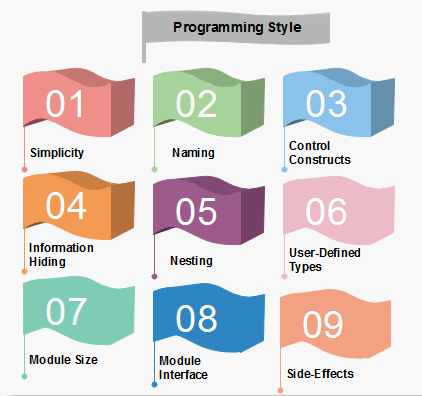Programming Style
Programming style refers to the technique used in writing the source code for a computer program. Most programming styles are designed to help programmers quickly read and understands the program as well as avoid making errors. (Older programming styles also focused on conserving screen space.) A good coding style can overcome the many deficiencies of a first programming language, while poor style can defeat the intent of an excellent language.
The goal of good programming style is to provide understandable, straightforward, elegant code. The programming style used in a various program may be derived from the coding standards or code conventions of a company or other computing organization, as well as the preferences of the actual programmer.
Some general rules or guidelines in respect of programming style:

1. Clarity and simplicity of Expression: The programs should be designed in such a manner so that the objectives of the program is clear.
2. Naming: In a program, you are required to name the module, processes, and variable, and so on. Care should be taken that the naming style should not be cryptic and non-representative.
For Example: a = 3.14 * r * r
area of circle = 3.14 * radius * radius;
3. Control Constructs: It is desirable that as much as a possible single entry and single exit constructs used.
4. Information hiding: The information secure in the data structures should be hidden from the rest of the system where possible. Information hiding can decrease the coupling between modules and make the system more maintainable.
5. Nesting: Deep nesting of loops and conditions greatly harm the static and dynamic behavior of a program. It also becomes difficult to understand the program logic, so it is desirable to avoid deep nesting.
6. User-defined types: Make heavy use of user-defined data types like enum, class, structure, and union. These data types make your program code easy to write and easy to understand.
7. Module size: The module size should be uniform. The size of the module should not be too big or too small. If the module size is too large, it is not generally functionally cohesive. If the module size is too small, it leads to unnecessary overheads.
8. Module Interface: A module with a complex interface should be carefully examined.
9. Side-effects: When a module is invoked, it sometimes has a side effect of modifying the program state. Such side-effect should be avoided where as possible.
